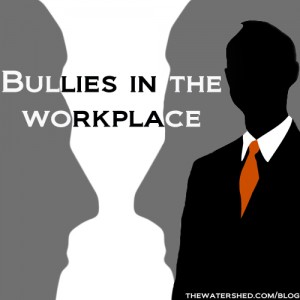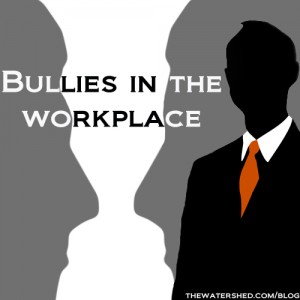Workplace Bullying

How workplace Bullying Affects Targeted Persons
Dr. Barrow continues her discussion regarding workplace bullying and how it affects targeted persons.
 Workplace bullying occurs when an employee experiences a persistent pattern of mistreatment from others in the workplace that causes harm. Workplace bullying can include such tactics as verbal, nonverbal, psychological, physical abuse and humiliation. This type of workplace aggression is particularly difficult because, unlike the typical forms of school bullying, workplace bullies often operate within the established rules and policies of their organization and their society. Bullying in the workplace is in the majority of cases reported as having been perpetrated by someone in authority over the target. However, bullies can also be peers, and on occasion can be subordinates. Recent research (2010) has also investigated the impact of the larger organizational context on bullying as well as the group-level processes that impact on the incidence, and maintenance of bullying behaviour. Bullying can be covert or overt. It may be missed by superiors or known by many throughout the organization. Negative effects are not limited to the targeted individuals, and may lead to a decline in employee morale and a change in organizational culture.
Workplace bullying occurs when an employee experiences a persistent pattern of mistreatment from others in the workplace that causes harm. Workplace bullying can include such tactics as verbal, nonverbal, psychological, physical abuse and humiliation. This type of workplace aggression is particularly difficult because, unlike the typical forms of school bullying, workplace bullies often operate within the established rules and policies of their organization and their society. Bullying in the workplace is in the majority of cases reported as having been perpetrated by someone in authority over the target. However, bullies can also be peers, and on occasion can be subordinates. Recent research (2010) has also investigated the impact of the larger organizational context on bullying as well as the group-level processes that impact on the incidence, and maintenance of bullying behaviour. Bullying can be covert or overt. It may be missed by superiors or known by many throughout the organization. Negative effects are not limited to the targeted individuals, and may lead to a decline in employee morale and a change in organizational culture.
Definitions
While there is no universally accepted formal definition of workplace bullying, several researchers have endeavoured to define it. Some categorize all harmful boss behaviour and actions of malintent directed at employees as bullying. Bullying behaviours may be couched in humiliation and hazing rites and iterative programs or protocols framed as being in the best interests of employee development and coaching. Others separate behaviours into different patterns, labeling a subset of those behaviours as bullying, explaining that there are different ways to deal effectively with specific patterns of behaviour. Some workplace bullying is defined as involving an employee’s immediate supervisor, manager or boss in conjunction with other employees as complicit, while other workplace bullying is defined as involving only an employee’s immediate supervisor, manager, or boss.
 A relatively comprehensive definition from Einarsen, Hoel, Zapf and Cooper (2003; pp. 15) “Bullying at work means harassing, offending, socially excluding someone or negatively affecting someone’s work tasks. In order for the label bullying (or mobbing) to be applied to a particular activity, interaction or process it has to occur repeatedly and regularly (e.g. weekly) and over a period of time (e.g. about six months). Bullying is an escalated process in the course of which the person confronted ends up in an inferior position and becomes the target of systematic negative social act.” It is relatively long definition comparing to the other works, but it is comprehensive which seems to sculpture all the aspects.
A relatively comprehensive definition from Einarsen, Hoel, Zapf and Cooper (2003; pp. 15) “Bullying at work means harassing, offending, socially excluding someone or negatively affecting someone’s work tasks. In order for the label bullying (or mobbing) to be applied to a particular activity, interaction or process it has to occur repeatedly and regularly (e.g. weekly) and over a period of time (e.g. about six months). Bullying is an escalated process in the course of which the person confronted ends up in an inferior position and becomes the target of systematic negative social act.” It is relatively long definition comparing to the other works, but it is comprehensive which seems to sculpture all the aspects.
According to Tracy, Lutgen-Sandvik, and Alberts, researchers associated with the Arizona State University’s Project for Wellness and Work-Life, workplace bullying is most often “a combination of tactics in which numerous types of hostile communication and behaviour are used.”
Gary and Ruth Namie define workplace bullying as “repeated, health-harming mistreatment, verbal abuse, or conduct which is threatening, humiliating, intimidating, or sabotage that interferes with work or some combination of the three.”
Pamela Lutgen-Sandvik expands this definition, stating that workplace bullying is “persistent verbal and nonverbal aggression at work, that includes personal attacks, social ostracism, and a multitude of other painful messages and hostile interactions.”
In an effort to provide a more all-encompassing definition, and catch the attention of employers, Catherine Mattice and Karen Garman define workplace bullying as “systematic aggressive communication, manipulation of work, and acts aimed at humiliating or degrading one or more individual that create an unhealthy and unprofessional power imbalance between bully and targets, result in psychological consequences for targets and co-workers, and cost enormous monetary damage to an organization’s bottom line.”
 Employers can also be bullies. Bad employers use bullying strategically to rid the workplace of good employees to avoid a legal obligation, such as paying unemployment compensation or a worker’s compensation claim. Employers also use bullying tactics to drive out employees who demand legal pay or overtime or assert a legal right to organize collectively. The most common type of complaint filed with the U.S. Equal Employment Opportunity Commission involves retaliation, where an employer harasses or bullies an employee for objecting to illegal discrimination. Patricia Barnes, author of Surviving Bullies, Queen Bees & Psychopaths in the Workplace, argues that employers that bully are a critical but often overlooked aspect of the problem in the United States.
Employers can also be bullies. Bad employers use bullying strategically to rid the workplace of good employees to avoid a legal obligation, such as paying unemployment compensation or a worker’s compensation claim. Employers also use bullying tactics to drive out employees who demand legal pay or overtime or assert a legal right to organize collectively. The most common type of complaint filed with the U.S. Equal Employment Opportunity Commission involves retaliation, where an employer harasses or bullies an employee for objecting to illegal discrimination. Patricia Barnes, author of Surviving Bullies, Queen Bees & Psychopaths in the Workplace, argues that employers that bully are a critical but often overlooked aspect of the problem in the United States.
http://en.wikipedia.org/wiki/Workplace_bullying

